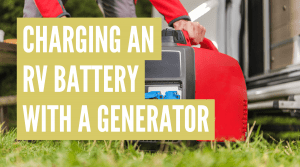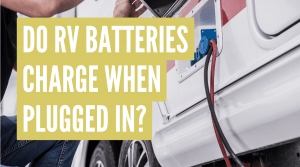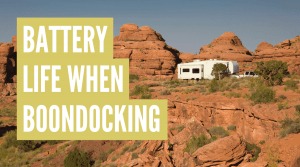Camper FAQs is reader-supported. Buying through links on our site may earn us an affiliate commission. As an Amazon Associate I earn from qualifying purchases.
An RV’s battery is charged when connected to a 120v electrical outlet (like a shore power pedestal at a campground), an onboard or external generator, the motorhome or tow vehicles alternator, solar power, or even wind power.
Let’s break these down in more detail and learn how to use each method to charge your RV’s batteries. Plus, we reveal the fastest way to charge RV batteries!
1. Power Converter/Charger

Arguably, the most common way to charge RV batteries is through its onboard power converter or a battery charger when hooked up to a 120v electrical outlet, like on a shore power pedestal at a campground.
Related: Does an RV Battery Charge When Plugged Into Shore Power?
Charging RV batteries with shore power is an automatic process. Simply plug the RV’s power cord into a 120v AC electrical outlet, and the batteries will start charging, if needed, through your RV’s power converter/charger. This converter converts the AC power to DC power so your batteries can charge properly.
You can also charge your RV’s 12-volt batteries with an external “smart” battery charger, which, depending on the charger model, can shorten the time it takes to charge your RV batteries on shore power. In fact, a high-amperage battery charger plugged into a 120v outlet is arguably the fastest way to charge an RV battery.
And don’t worry if your camper has 6v batteries, as they will be wired together in pairs to create 12 volts.
Important: We are talking about charging your RV’s deep-cycle house batteries. Depending on the make and model of your motorhome, your RV battery system may (or may not) be designed to charge your chassis battery.
This method is also used to trickle charge your lead-acid battery while your RV is in storage for the winter. It’s crucial to trickle charge these types of batteries as it helps to avoid sulfation and extend their service life.
💡Additional Note
Understanding Amp-Hours vs. Watt-Hours
RV batteries are usually rated in amp-hours (Ah), but this doesn’t tell you the full energy capacity unless you also know the voltage. To compare battery capacity more accurately, you can convert amp-hours to watt-hours (Wh) using the formula:
Watt-hours = Amp-hours × Voltage
For example, a 100Ah 12V battery provides about 1,200Wh of energy. Two 6V 100Ah batteries wired in series also give you 12V at 100Ah, which equals the same 1,200Wh. This distinction is helpful when comparing battery setups or estimating how long your batteries will run certain devices.
Because it’s a critical step to winterize your camper, let’s quickly look at how to trickle charge RV batteries in storage step-by-step:
Important: Wear safety goggles and protective gloves when working on or near lead-acid batteries.
- Remove the battery from your recreational vehicle
- Fully charge the battery
- Depending on the battery type, you may need to check the water levels and fill if needed (do not fill AGM batteries with water)
- Store the battery in a warm location, preferably indoors
- Attach a battery maintainer or battery tender to keep it charged during storage

Schumacher Fully Automatic Battery Charger and Maintainer 15 Amp/3 Amp
Price:Clicking this link to make a purchase may earn us a commission at no additional cost to you.
Check out our guide on how to store an RV battery for winter for the complete step-by-step process and a few important tips.
2. Generator

Another fast way to charge your RV batteries is with an RV generator, whether an onboard generator or a portable generator.

Honda EU3000IS 3000W 120V Inverter Generator
Price:Clicking this link to make a purchase may earn us a commission at no additional cost to you.
Simply connect the RV power cable to the gas generator’s 30 amp/120-volt power outlet, just as you would a shore power pedestal, and your RV batteries will start recharging. Remember, you’ll need an adapter if your generator features a 220-volt outlet.
Of course, that’s just a high-level overview. Check out our guide on how to charge an RV battery with a generator for the full step-by-step process, complete with important safety precautions.
3. Vehicle Alternator

Another option is to charge your RV batteries while driving using the alternator on your truck or any tow vehicle, with a 7-pin travel trailer plug.
If you have a motorhome, the alternator should automatically charge both your house and vehicle batteries while the engine is running (in most models).
With that in mind, don’t expect your vehicle’s alternator to provide a fast charge to your RV batteries while on the road.
So, how long does it take to charge RV batteries?
A long time, as your standard, out-of-the-box setup, is more of a trickle charge than anything.
But you can drastically speed up the charging process by adding a DC to DC battery charger to your vehicle’s charging system. Essentially, this boosts the charging amps from around 5 amps to 20 amps, providing a quicker charge from your alternator to your house batteries.

Renogy DC to DC Battery Charger (20, 40, or 60 amp)
Price:Clicking this link to make a purchase may earn us a commission at no additional cost to you.
Check out our guide to charging an RV battery while driving with a DC-to-DC charger for instructions and tips to install this fast-charging system.
4. Solar Power
The sun is a free and convenient energy source, allowing you to charge your RV batteries and operate electrical devices without needing a generator or anywhere shore power isn’t accessible.
Essentially, a solar-power charging system will look like this diagram.

Most RVs don’t come with a solar charging setup, so there is a bit of up-front investment to get the necessary supplies for a complete solar system (portable solar panels, solar charge controller to regulate voltage, wires, etc.). And there can be a bit of a learning curve when installing solar panels on your RV.
However, we covered in detail how to install a solar power system using the Renogy Complete RV Solar System Kit. This kit has everything you need to get your solar system up and running in no time.
So, check out our guide on How to Hook up Solar Panels to RV Batteries for the exact step-by-step process, along with an instructional video to help you get everything set up correctly.

Renogy 400 Watt 12 Volt Monocrystalline Solar Starter Kit
Price:Clicking this link to make a purchase may earn us a commission at no additional cost to you.
5. Wind Power
Harnessing wind power to charge RV batteries is a far less common but possible option for those looking to reduce their environmental impact and enhance their off-grid charging capabilities.
This method involves setting up a wind turbine system that converts wind energy into electrical energy, which is then used to charge the RV’s batteries.

While it comes with some challenges, like initial costs and dependency on wind, the benefits of utilizing a clean, renewable energy source may outweigh the disadvantages for some RV owners.
I personally wouldn’t rely on the wind as the sole power source for my batteries, especially when boondocking, but combined with another option, it might be worthwhile.
What Is the Best Way to Charge RV Batteries?
The best way to charge RV batteries will depend on what’s available to you at that moment, how fast you need your batteries recharged, and a host of other factors. Typically, the best way to charge your RV batteries from a campsite or at home is to use your shore power cord plugged into a 120-volt outlet (like the shore power pedestal or wall outlet).
If you’re boondocking with no access to electricity, a generator or RV solar charger will be the best way to charge your batteries.
Related: Best RV Battery for Boondocking & Dry Camping
Lastly, if none of the above are an option, you can rely on your vehicle’s alternator to recharge your camper’s batteries.







Batteries have maximum recommended charge rates. Faster charging (or discharging) is harder on the batteries, depending on how much you care about cycle life.
For lead-acid, 0.1 C (1/10 of capacity) to 0.3 C.
For LiFePO4, 0.3C to 1.0 C.
Distinguish Amp-hours from Watt-hours (Amp-hours × voltage).
I aways just use shore power. I’ve never heard of somebody setting up a windmill to power their camper. Interesting. But seems like a lot of work to set it up, etc. for little reward.
It would be interesting to get feedback from somebody who has experience using a wind turbine for this purpose. Like with anything, there are pros and cons.
have you heard of any issues while the travel trailer is plugged into 1 20 amp household outlet and eventually will trip the circuit breaker at the house breaker panel. could it be the inverter?